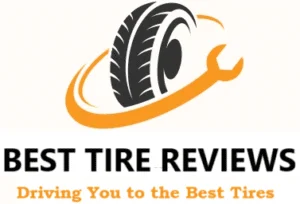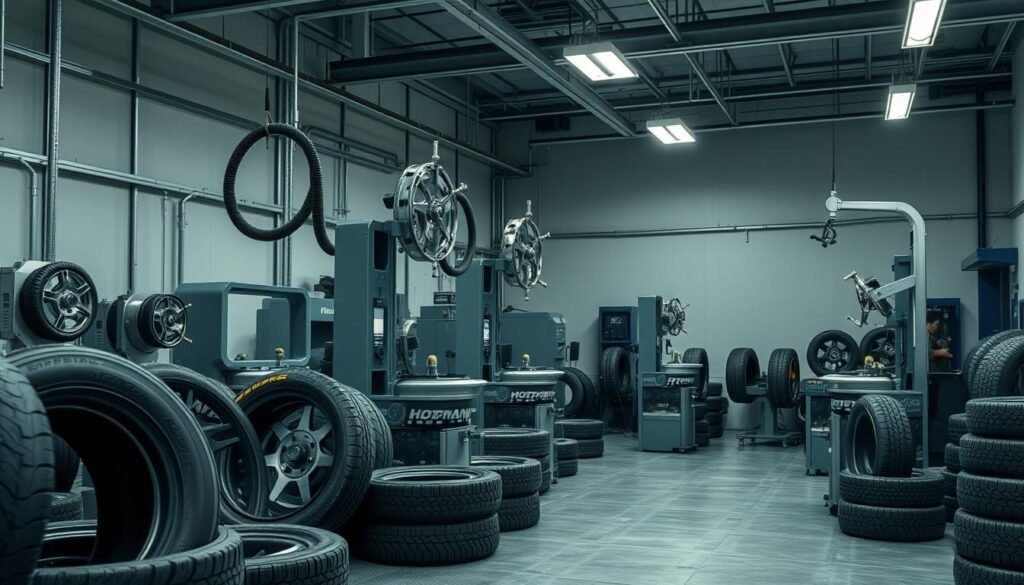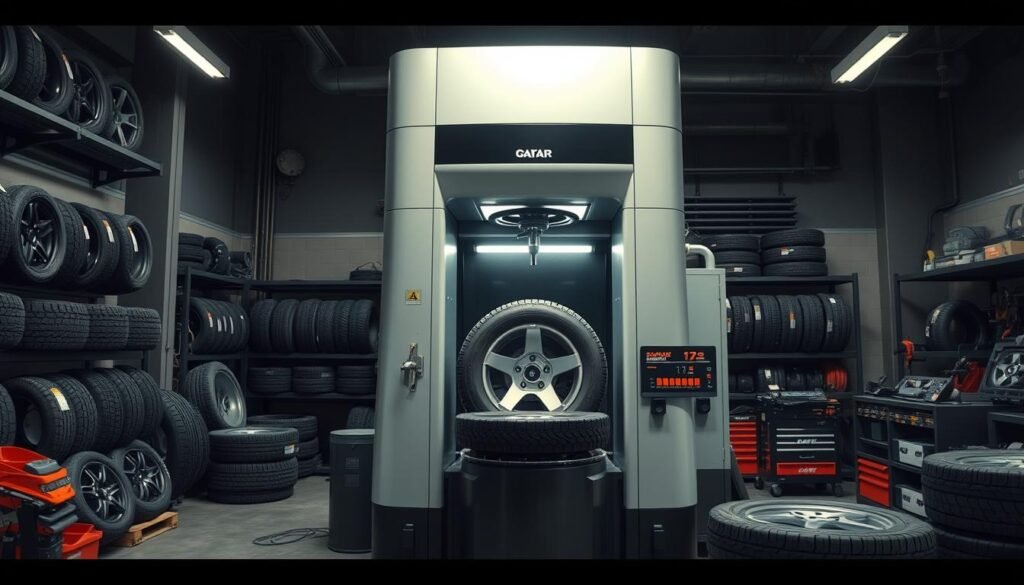Did you know 4 out of 5 tire changers in shops are tilt-back? They are made for easy use and efficiency. Modern tire changers have cool features like pneumatic control valves and polyurethane seals. These make them last longer and work better.
From CEMB’s heavy-duty units to Ranger’s Next Generation™, there’s equipment for every shop. Brands like Hofmann make changers easy to use. Corghi’s automated changers add precision and make customers happy. Getting a good tire changer is key for car repair pros.
Key Takeaways
- 4 out of 5 tire changers in use are tilt-back models for optimal efficiency.
- Modern tire changers feature advanced pneumatic control valves for improved lifespan.
- High-end models, like Ranger’s NextGen series, utilize touchless technology for enhanced performance.
- State-of-the-art brands, including Hofmann and Corghi, offer specialized equipment to meet various shop demands.
- Leverless tire changers are increasingly recommended for delicate high-end wheels.
- Maintaining tire changers with regular checks can ensure long-term effectiveness and safety.
Importance of a Quality Tire Changer
A good tire changer is key for better wheel service. It saves a lot of time and makes work smoother. This helps both customers and service teams a lot.
As tire changers get better, businesses see big gains. They become more productive and profitable.
Benefits of Using a Tire Changer
Using a quality tire changer has many benefits:
- Reduced Labor Time: It makes tire changes much faster than doing it by hand.
- Minimized Damage Risks: It helps avoid damaging the rim, keeping customers happy.
- Cost Savings: It cuts down on labor costs, saving money for auto shops.
How a Tire Changer Improves Efficiency
Adding a quality tire changer makes service work better. Modern machines can handle big wheels, up to 40 inches wide. This lets them work on many different cars.
The bead breaker is very strong, making tire changes quick. It has features like:
- Rotational speed of 6-12rpm, making work faster.
- Net weight of 170kg, keeping it stable while working.
This means teams can do more in less time. They can turn over more work each day. This makes the investment in a tire changer worth it.
By checking tires often and replacing them when needed, service stays safe and reliable.
Types of Tire Changers Available
Tire changers vary in how much they do on their own. Each type is good for different places and people. Knowing about manual, semi-automatic, and fully automatic tire changers helps you choose the right one.
Manual Tire Changers
Manual tire changers need you to do everything. They are great for small shops or special jobs. They cost less than automatic ones.
They are good for mechanics who like to do things by hand. They work well in tight spaces. But, they take more time and effort to use.
Semi-Automatic Tire Changers
Semi-automatic tire changers mix manual and automatic features. They help you work faster but still need some help. They are good for places that change tires a lot.
They can handle many tire sizes. They are faster and more consistent than manual ones. This means you can do more work in less time.
Fully Automatic Tire Changers
Fully automatic tire changers are the most advanced. They need very little help from you. They are perfect for busy shops that want to work faster.
They can handle all kinds of tires, even the biggest ones. They have cool features like touchless technology. Brands like Hofmann and Ranger make them. They are durable and efficient, making them a smart choice for businesses.
Essential Features to Look For in a Tire Changer
When you buy a tire changer, knowing what to look for is key. This helps make sure it works well and makes your job easier. Important features include how powerful it is, how easy it is to use, and how safe it is.
Motor Power and Speed
The power of a tire changer’s motor matters a lot. It helps it handle different tire sizes well. If it’s powerful, it can break and mount beads faster, which is great for busy places.
There are different voltages like 110v and 220v. These options help meet different needs. They make sure the changer has enough power and speed, especially for big or hard tires.
Ease of Use and Operation
Good tire changers are easy to use. They help new technicians learn fast. They have foot controls, simple interfaces, and designs that are easy on your body.
With the latest models, you can work faster and make fewer mistakes. This is very important in places that are always busy.
Safety Features
Safety is always the most important thing in a workshop. Look for tire changers with safety features like automatic clamps and strong safety locks. Brands like Weaver and Ranger have these features.
These safety features protect you, especially in places that are always busy. They help make sure you can work safely and efficiently.
Comparison of Popular Tire Changer Brands
The market for tire changers has many brands. Each brand has its own special features and benefits. We will look at Hofmann, Coats, and Ranger tire changers. They cater to different needs and users.
Hofmann Tire Changers
Hofmann tire changers are known for their quality and strength. They can handle many tire sizes. They are reliable for both home and business use.
Coats Tire Changers
Coats tire changers have a great lineup, like the Maxx series. The Maxx series was tested for four years with up to 250,000 cycles. It has:
- Flexible power options for different shops.
- Dual nozzle inflation system for better efficiency.
- Dual control bead loosener for easier use.
- Strong chassis for bigger wheels.
The Maxx line lets users upgrade without changing their workspace. It offers better service and convenience.
Ranger Tire Changers
Ranger tire changers are known for their advanced tech and designs, like the NextGen™ series. Ranger compares their products to others. They look at:
- How well they work with different tires.
- How much they cost compared to their value.
This careful approach ensures Ranger’s tire changers meet today’s needs.
Tire Changer Maintenance Essentials
Keeping your tire changer in good shape is key. It helps it work well for a long time. Regular care means less time waiting and more work done.
Regular Lubrication
Oil keeps the tire changer’s parts moving smoothly. It stops them from wearing out too fast. A regular oil schedule keeps your machine running strong.
Checking and Replacing Tires and Tools
It’s important to check tires and tools often. This makes sure everything works right and safely. Replacing old parts stops accidents and saves money.
Proper Storage Practices
Storing your tire changer right is very important. Keep it in a clean, dry place to avoid rust. Good storage keeps your equipment ready to go for a long time.
How to Choose the Right Tire Changer for Your Needs
Choosing the right tire changer is important. You need to think about your budget, the size of the changer, and how often you’ll use it. These things affect your choice and how well the changer works for you.
Budget Considerations
First, decide how much you can spend on a tire changer. Remember to include the cost of installation and any future service. Automatic tire changers are more expensive but work faster and better.
Leverless tire changers are even more expensive. But they make changing tires easier and faster. This is great for shops that change a lot of tires.
Space and Size Requirements
Think about the space you have in your shop. Make sure there’s enough room for the tire changer and for people to move around. Some tire changers, like those with power assist arms, take up more space.
But, they can make changing tires faster and easier. This is especially true for shops that work on big tires.
Frequency of Use
How often you’ll use the tire changer matters a lot. Shops that change a lot of tires should get automatic models. They save time and make more money.
Shops that don’t change tires as often might be able to get away with cheaper models. Knowing how often you’ll use it helps you choose the best tire changer for your shop.
Tire Changer Installation Requirements
Installing a tire changer needs careful planning. You must know the tools, space, and safety steps. This ensures the tire changer works well and safely.
Necessary Tools and Setup
For a tire changer installation, you need some key tools. These tools help set up and use the tire changer right:
- Wrenches
- Screwdrivers
- Power drills
- Leveling tools for accurate positioning
You might need more tools based on the tire changer model. Reading the manual helps a lot with the setup.
Space Considerations and Layout
Enough space is key for the tire changer and for safety. Think about these points:
- Make sure there’s enough room around the tire changer for easy access.
- Have enough space for working and keeping the tire changer in good shape.
- Think about overhead and side space for safety and handling equipment.
Safety Precautions During Installation
Keeping safe during installation is very important. Here are some safety tips:
- Always follow the maker’s rules and local laws for safety.
- Make sure electrical connections are safe and right.
- Put on all machine guards and adjust them before using.
- Wear safety gear like steel-toed shoes and eye protection.
- Know the max tire pressure for the tire changer, which is 40 psi.
Following these tips and safety rules makes installing a tire changer safer and more efficient.
Cost of Tire Changers: What to Expect
Knowing the cost of tire changers is key for pros and hobbyists. It’s important to know the price ranges and what affects the cost. Thinking about the return on investment helps decide if these tools are worth it for your shop.
Price Ranges for Different Models
Tire changers come in many types, fitting different needs and budgets. Here’s a quick look at the price ranges for different types:
| Type of Tire Changer | Price Range |
|---|---|
| Manual Tire Changers | $1,500 – $3,000 |
| Semi-Automatic Tire Changers | $3,000 – $6,000 |
| Fully Automatic Tire Changers | $6,000 – $10,000+ |
| Rim Clamp Machines | $2,000 – $6,000 |
Factors Influencing Cost
Several things can change the cost of a tire changer:
- Brand Reputation: Brands like Ranger Products and BendPak offer good prices and quality.
- Technological Advancements: New tech like digital sensors and quick-release nuts can raise the price.
- Build Quality: Better engineering and design mean the tool lasts longer, affecting the cost.
- Additional Features: Extras like outside clamping and handling big wheels can also raise the price.
- Shipping Costs: Shipping can add to the cost, especially for far-off places.
Return on Investment Considerations
Thinking about the return on investment for tire changers is important. For busy shops, buying fully automatic models can save a lot of money. Look at these points:
- Increased Productivity: Faster service means more money.
- Cost Efficiency: Better tire changers can mean fewer returns and repairs.
- Longevity of Equipment: Durable machines cost less to replace over time.
Common Issues with Tire Changers and Troubleshooting Tips
Tire changers can have problems that slow them down. Knowing these issues and how to fix them is key. Troubleshooting early can save time and money. Here are some common problems and how to solve them, plus tips for keeping things running smoothly.
Mechanical Problems and Solutions
Worn belts and broken motors are common issues. If the turntable moves slowly or makes grinding sounds, it might need fixing. Regular checks can catch these problems before they get worse. Make sure to:
- Check belts for wear
- Test motors
- Replace parts as needed
- Keep air pressure high for better bead breaking
Software Errors in Automatic Models
Automatic tire changers can have software problems. This might show as controls not working or wrong readings. Keeping the software up to date is important. If problems happen, look at the manual for help. Remember, batteries might need replacing if the gauge doesn’t work.
Maintenance to Avoid Issues
Keeping up with maintenance is crucial. Here are some tips to keep your equipment in top shape:
- Use plastic covers for alloy rims to avoid scratches
- Apply lubricant to the bead seat and other key areas
- Know where the TPMS sensor is to avoid damage
- Keep tools clean and properly assembled
- Replace the motor if it stops working after a long time
Regular maintenance makes tire changers work better and last longer. It ensures they’re ready for the next job.
| Issue Type | Description | Solutions |
|---|---|---|
| Mechanical Problems | Worn belts, slow turntable, grinding noises | Regular inspection, component replacement, scheduling maintenance |
| Software Errors | Unresponsive controls, incorrect readings | Keep software updated, refer to manufacturer manuals |
| Maintenance Issues | Improper lubrication, TPMS damage risk | Follow lubrication guidelines, inspect TPMS locations regularly |
Tips for Operating a Tire Changer Safely and Effectively
Using a tire changer safely makes work better and safer. You need to know how to use it well. This means learning about the machine and how to use special tools.
It’s also important to know the risks. This way, you can do your job with confidence.
Training and Skills Needed
Learning specific skills is key. You need to know how to use the foot pedals and the mount/demount head. It’s also important to know how to adjust tire pressure and fix bead seating issues.
Keeping the tire changer calibrated helps avoid damage. It also makes work faster in a busy place.
PPE and Safety Gear
Wearing the right safety gear is crucial. Gloves, goggles, and steel-toed boots protect you. They help prevent injuries when changing tires.
Following the maker’s advice is also important. This includes inflating tires to the right pressure. Using lubricant also helps make the job safer.
Proper Work Environment Setup
A clean and organized space is essential. A well-lit area helps you move safely and avoid accidents. Having tools and parts within reach makes work easier.
Being careful about hazards like clutter is important. Keeping the area safe and tidy helps you work better and safer.













